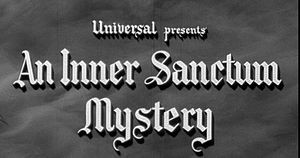June 215
Years ago, before television, there was a radio mystery show called “Inner Sanctum.” Yes, I am old enough to remember listening to the show which was quite scary for a youngster with a great imagination shivering under the sheets at night.
The author* of a book I was just reading used the term “inner sanctum” to describe his inner world and, while I was reminded of the old radio show, I also liked his use of the term and felt inspired to write about it. So here goes.

Dictionaries define the term as the most sacred place in a temple or church, or a private or secret place to which few other people are admitted. Sound familiar? Like maybe our minds, the private sanctuary is where no one else is allowed, or our souls where few are admitted – sometimes not even ourselves! At least not our walking-around-not-paying-much-attention selves. This “private and secret place” is where our darker sides reside, what Jung called our “shadow,” where we keep hidden all those parts of ourselves we don’t want others to see. Many times these parts are so well hidden we aren’t even aware of them ourselves.
I call these hidden parts of ourselves the “negative ego,” what Canadian author Art Horn** defines as “the part of you that sees yourself as above, below or against other people or circumstances.” Very concise! This is my favorite definition of negative ego.
There is certainly as much mystery involved in this personal inner sanctum as there was for the old radio program. Psychotherapists, psychiatrists and other mental health professionals are paid to help people shine light on all the darker parts of themselves. For those of us on a consciousness path, we know this is a lifetime commitment – becoming aware of all the bits of ourselves we have stowed away in those private and secret places.
If we can end each day by telling ourselves truthfully that we have made progress on our aspiration to become more conscious, it was a good day. Attempts to get it all done at once might be that negative ego popping up again, convincing us that what others may need a lifetime to do, we can do in an instant. Self-aggrandizement lives!
Most 12 Step programs advocate progress over perfection, warning the addict that they should focus on making progress in getting better rather than trying to do everything perfectly. Seeking perfection is often the cause for “going out” or succumbing to the addiction and relapsing. The same applies to becoming more conscious. That voice that says you can do it better, faster or differently than other human beings is often coming from your shadow.
Like a spelunker, our dives into our own “inner sanctums” are ongoing adventures. We don’t just do it once and we’re done. Trying to recognize all the things we have hidden from ourselves for most of our lives takes time.
Dive deep, learn and grow. Once you begin to really know yourself, you can learn to love yourself, your whole self, even with those faults, foibles and warts. Love yourself as you are, not as you would like to be or as you would like to be seen.
As I wrote in April in “Leading as Love,” we must know ourselves before we can love ourselves and we need to love ourselves before we can really love others. And we need to love others before we can lead with love.
*Thanks to Kenny Johnson for triggering the memory for me in his book The Last Hustle.
**Beyond Ego: Influential Leadership Starts Within, by Art Horn, ECW Press, 2008